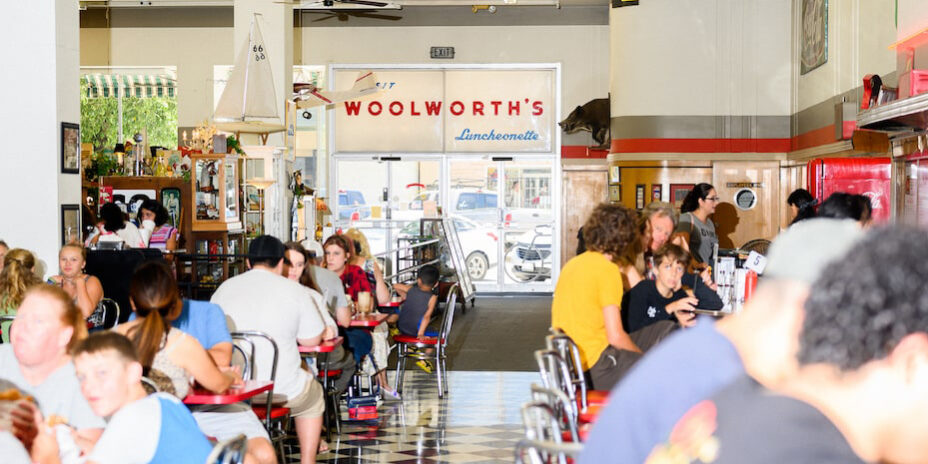World’s Largest Buffalo in Jamestown turning 60

Dakota Thunder, also known as the World’s Largest Buffalo, marks 60 years of looking over southern Jamestown this summer. The roadside attraction was built in the summer of 1959 at a cost of $8,500. Keith Norman • Jamestown Sun
From Williston Herald Media: JAMESTOWN — Physically, sculptor Elmer Petersen and his crew built the World’s Largest Buffalo 60 years ago this summer. What they also created is a symbol that became synonymous with Jamestown, according to Serle Swedlund, executive director of Jamestown Tourism.
“This buffalo brought Jamestown an identity long before marketing and branding were concepts,” he said. “It is less about what it creates than how it is adopted in the community.”
One of the World’s Most Stunning Churches Is in Tulsa, Oklahoma

Photo Illustration by Lyne Lucien/The Daily Beast/William O’Connor
From the Daily Beast: Maybe we’ve been a little too hard on oil money.
It’s long been a cliche for arriviste tackiness. But a recent trip of mine to a former oil capital of the world—Tulsa, Oklahoma—proved a reassessment was in order.
In fact, so overwhelming was the amount of preserved early 20th-century architecture that on our last day we turned to one another and declared, “I don’t think I can see another Art Deco building.” (And we love Art Deco).
New exhibit pays tribute to iconic Vegas Vic

Who is Vegas Vic? Jason Bracelin/Las Vegas Review-Journal
From the Las Vegas Review-Journal: It began with a cigarette and a wink.
One of the greatest promotions in a city of great promotions was just a face and a head at first, bereft of a name or a torso.
The Smiling Cowboy, they called him.
The year was 1945.
That’s when the Las Vegas Chamber of Commerce hired New York City’s J. Walter Thompson advertising agency to create a symbol, a character, something to represent and personify the city, to lure still more people to what was becoming a burgeoning tourist destination.
Time stands still for clock at the old Molson Brewery

The former Molson Brewery building at Burrard and Cornwall. GERRY KAHRMANN / PNG
From the Vancouver Sun: Since 1953, a “weather beacon” and clock have been broadcasting the time and temperature to Vancouverites passing by the Molson Brewery at the south end of the Burrard Bridge.
No more.
Late last week, crews took the Molson lights and logo off the tower on top of the brewery, and turned off the digital time and temperature.
Molson (which is now called Molson Coors) sold the property at 1550 Burrard to Concord Pacific in 2016, and has been leasing it back while building a new brewery in Chilliwack.
Exhuming the Signage of the Long Lost ‘Garden Cafeteria’ on East Broadway

Photo: Museum at Eldridge Street
From Bowery Boogie: Visitors to the Museum at Eldridge Street will be treated to an extra dose of neighborhood nostalgia, now that a massive sign from the beloved Garden Cafeteria has been installed on its walls.
The East Broadway restaurant was once a Lower East Side institution, and for decades served as an intellectual hub for the area. From 1941 until the restaurant’s closing in 1983, the eye-catching sign served as an icon of the Rutgers Square community. After spending decades either covered up or in storage, the sign is once again on display to the public inside the landmark synagogue on Eldridge Street.
At the country’s last remaining Woolworth’s lunch counter, burgers are served with a side of Civil Rights history

Photo: Tag Christof
From Roadtrippers: When we think of the battlefields in America’s long fight for civil rights, we tend to think of a few specific places: the Edmund Pettus Bridge in Selma, the front seats of city buses, the Lorraine Motel, for instance. But segregation was rampant in almost every type of public space, from hotels, schools, department stores and churches, to even the most casual of restaurants.
The lunch counters at Woolworth’s department stores were once such places: They were fixtures in almost every American city, yet many remained staunchly segregated well into the postwar years.


